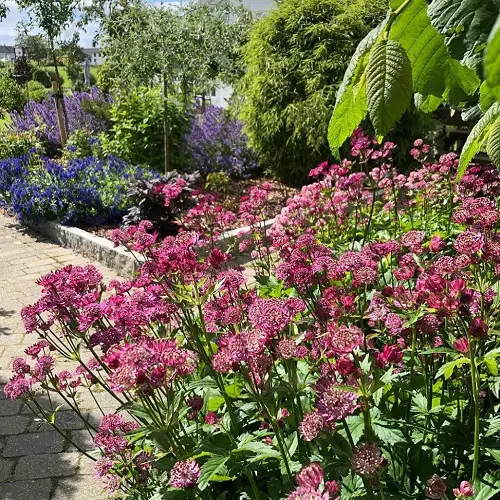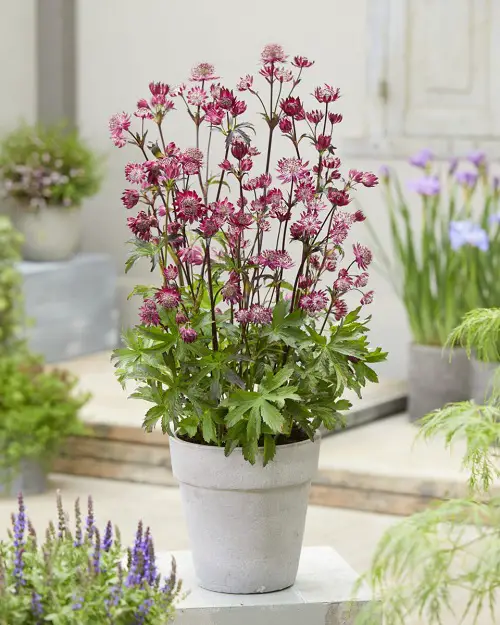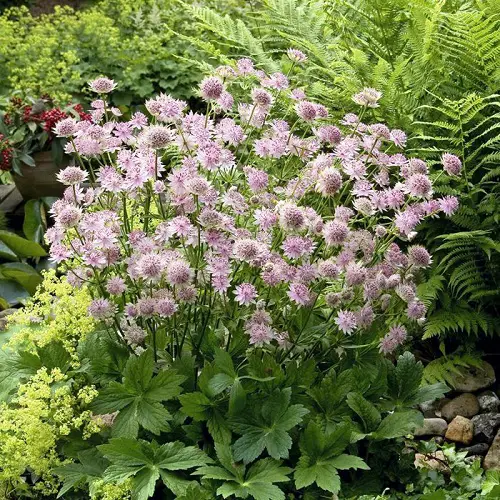Learn How to Grow Astrantia and add the beauty of its pink-red flowers to the landscape. You can also grow it easily in pots!
Uncover the secrets of successful Astrantia propagation and learn How to Grow Astrantia to full blooming glory. From choosing the ideal planting location to providing optimal care, this guide will empower you to grow exquisite Astrantia plants that will flourish and enchant your garden.
USDA Zones: Astrantia hardiness zones are 5-9
Astrantia Common Name: Masterwort, Greater Masterwort, Melancholy Gentleman, Hattie’s Pincushion
Astrantia Plant Information
Astrantia, also known as Masterwort, is a genus of flowering plants native to Europe and Western Asia. These herbaceous perennials are highly prized for their intricate and delicate blooms, making them popular choices for gardens and floral arrangements.
Do you know about the astrantia height? Astrantia plants have long, slender stems reaching heights of about 1 to 3 feet (30 to 90 centimeters). At the top of each stem, clusters of exquisite flowers emerge, resembling pincushions or starbursts. One of the unique characteristics of Astrantia flowers is their intricacy. Each bloom is composed of a central umbel surrounded by several bracts, which resemble petals and provide an ornamental effect.
With their captivating appearance, unique flower structures extended blooming period, and ecological value, Astrantia plants bring a touch of elegance and charm to any garden setting.
How to Grow Astrantia?

- Begin the process of growing Astrantia from seeds by selecting fresh, high-quality seeds from a reputable source. Opt for seeds that have been recently harvested to ensure optimal germination rates and viability.
- To create an ideal environment for seed germination, start indoors during late winter or early spring. Use a seed tray or small pots filled with a well-draining seed starting mix.
- Before sowing the seeds, lightly moisten the soil in the seed tray or pots. This will provide a suitable base for seed placement and germination. Avoid saturating the soil, as excessively wet conditions can lead to rotting.
- Sprinkle the Astrantia seeds evenly over the surface of the soil, ensuring they are not buried too deeply. Astrantia seeds are small, so light and even distribution will help prevent overcrowding and provide space for each seedling to grow.
- Gently press the seeds into the soil using your fingers or a flat object, ensuring good contact between the seeds and the soil. This step aids in the transfer of moisture and nutrients to the seeds, promoting successful germination.
- Position the covered seed tray or pots in a warm location with indirect sunlight. Maintaining a consistent temperature around 65°F to 75°F (18°C to 24°C) is ideal for Astrantia seed germination. Avoid placing the seeds in direct sunlight, as it may cause excessive drying or overheating.
- While the seeds are germinating, it’s important to keep the soil consistently moist but not waterlogged. Check the moisture level regularly and water gently using a misting spray bottle or a watering can with a fine nozzle.
- Astrantia seeds typically take around 3 to 4 weeks to germinate, although germination times may vary depending on seed quality and environmental conditions. Patience is key during this period, and maintaining consistent moisture and warmth will increase the chances of successful germination.
- Once the Astrantia seedlings have grown a few inches tall and developed their second set of true leaves, they are ready to be transplanted into individual pots.
Here are 12 Simple Seed Germination Tips To Grow Every Seed
Plant Pot Size for Growing Astrantia
Begin with a pot that has a diameter of at least 8 to 10 inches (20 to 25 centimeters) to accommodate the initial growth of a young Astrantia plant. Ensure the pot has drainage holes to prevent waterlogging and promote healthy root development.
As the Astrantia plant matures, you may need to transplant it into a larger container to provide adequate space for its expanding root system.
Here are Plant Pot Sizes from Inches to Gallon
Requirements for Growing Astrantia
Worried about your astrantia plants? Here are the perfect astrantia growing conditions.
Sunlight
Astrantia major prefer a partially shaded environment. It thrives in areas where it receives dappled sunlight or about 4 to 6 hours of direct morning or late afternoon sun.
Avoid exposing it to intense midday sunlight, as it may scorch the leaves.
Soil
This plant thrives in well-draining soil that is rich in organic matter. It prefers a slightly acidic to neutral pH level, ranging from 6.0 to 7.0. Loamy or sandy soils are ideal, as they provide good drainage while retaining sufficient moisture.
Learn How to Check the Soil pH at Home here
Water
Adequate moisture is essential for Astrantia, but it also requires well-drained soil to prevent waterlogging. Water the plant regularly, keeping the soil evenly moist but not overly saturated.
Here are the best ways to water plants
Avoid letting the soil dry out completely between waterings, as it may cause stress to the plant.
Temperature & Humidity
Astrantia generally grows well in moderate temperature ranges. It prefers temperatures between 60°F (15°C) and 75°F (24°C) during the growing season. While it can tolerate slight fluctuations, it may struggle in extreme heat or cold. Protect the plant from frost during winter by applying a layer of mulch around its base.
Astrantia is adaptable to varying humidity levels. It can tolerate average to high humidity, but it also grows well in drier conditions. Maintaining a moderate humidity level of around 40% to 60% is generally suitable for its growth. If the air becomes excessively dry, consider using a humidifier or misting the plant occasionally.
Here are 10 Ways To Increase Humidity For Houseplants That Work
Astrantia Plant Care

Fertilizer
Astrantia major benefits from regular fertilization to promote healthy growth and abundant flowering. Apply a balanced, slow-release fertilizer in early spring, following the package instructions. A general-purpose fertilizer with equal ratios of nitrogen, phosphorus, and potassium (such as 10-10-10) works well.
Avoid over-fertilization, as it can lead to excessive foliage growth and reduced flower production.
Want to Make Organic Fertilizers from Kitchen Scraps? Click here
Pruning
Pruning Astrantia helps maintain its shape, improve airflow, and remove spent flowers. In late winter or early spring, cut back the old stems to the ground level before new growth appears. This stimulates fresh growth and encourages the production of new flowers.
Additionally, you can deadhead faded blooms throughout the growing season to prolong flowering. Use clean, sharp pruners and ensure proper sanitation to minimize the spread of diseases.
Pest and Diseases
Astrantia is generally a hardy plant with few major pest or disease issues. However, like any plant, it can be susceptible to certain problems. Keep an eye out for common garden pests such as aphids and slugs. If you notice an infestation, use organic pest control methods like insecticidal soap or beer traps for slugs.
This Amazing Natural Pesticide Recipe Is So Effective You Can Get Rid Of Pests In No Time
As for diseases, Astrantia flowers may occasionally be affected by powdery mildew or leaf spot. Ensure good air circulation, avoid overhead watering, and remove any infected plant material promptly to prevent the spread of diseases.
Frequently Asked Questions
1. What Is Astrantia Flower Meaning?
The Astrantia flower is commonly associated with charm, protection, and gratitude. It symbolizes strength and courage while expressing appreciation and admiration.
2. Will Astrantia Grow in Shade?
Yes, Astrantia can tolerate partial shade and even thrive in dappled sunlight. It prefers a location that receives a few hours of direct morning or late afternoon sun but is protected from intense midday sunlight.
3. Are Astrantia Poisonous to Dogs?
Astrantia is considered non-toxic to dogs. However, it’s always a good idea to monitor your pets around any plants and prevent them from ingesting large quantities of any plant material to avoid potential digestive discomfort.
Have a pup? Here are Dog Friendly Plants you should grow
4. What Are Astrantia Companion Plants?
Astrantia, with its charming and delicate blooms, can be beautifully complemented by various companion plants. Some popular choices include ferns, such as Athyrium or Dryopteris, which provide contrasting textures and a lush backdrop. Other compatible options are low-growing perennials like Geraniums, Heucheras, or Campanulas, which create a harmonious blend of colors and forms.




